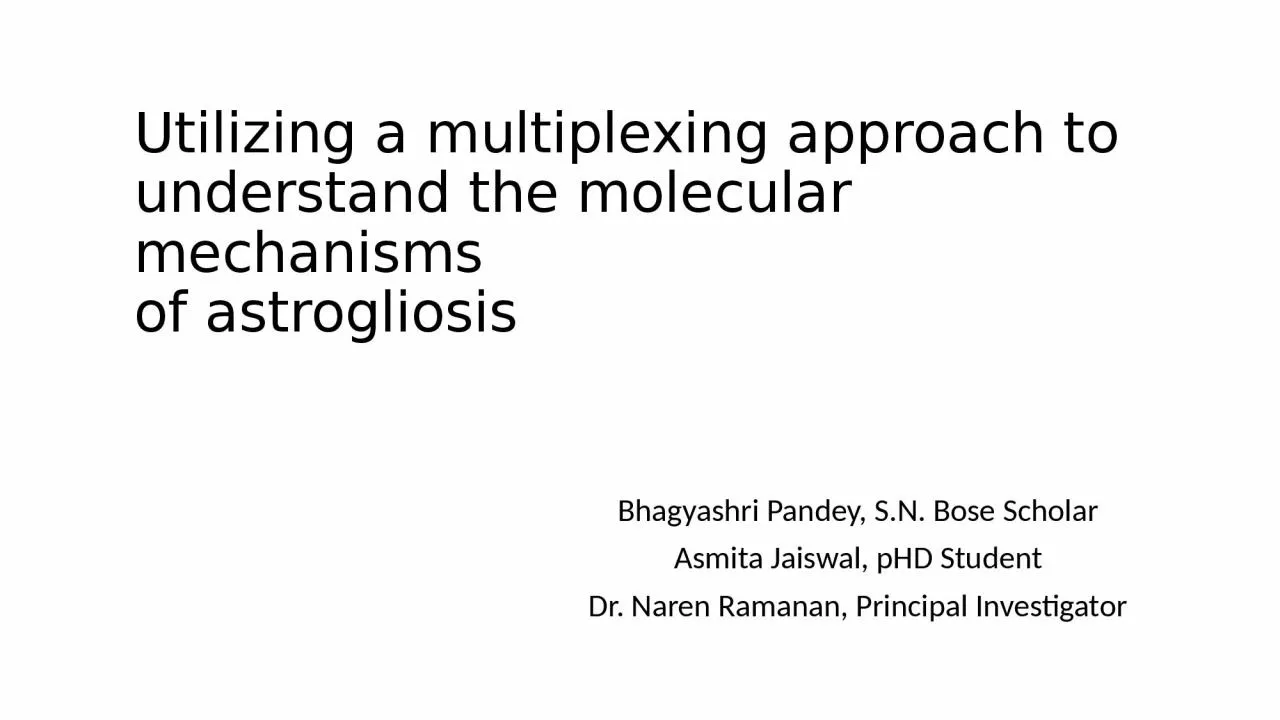

understand the molecular mechanisms of astrogliosis Bhagyashri Pandey SN Bose Scholar Asmita Jaiswal pHD Student Dr Naren Ramanan Principal Investigator Astrocytes Regulate blood flow ID: 933597
Download Presentation The PPT/PDF document "Utilizing a multiplexing approach to" is the property of its rightful owner. Permission is granted to download and print the materials on this web site for personal, non-commercial use only, and to display it on your personal computer provided you do not modify the materials and that you retain all copyright notices contained in the materials. By downloading content from our website, you accept the terms of this agreement.
Slide1
Utilizing a multiplexing approach to understand the molecular mechanismsof astrogliosis
Bhagyashri
Pandey, S.N. Bose Scholar
Asmita
Jaiswal,
pHD
Student
Dr.
Naren
Ramanan
, Principal Investigator
Slide2AstrocytesRegulate blood flowNurture neurons
Participate in ensuring successful neurotransmission
Maintain plasticity
Respond to insults made to the CNS Sofroniew, 2009
2
http://jonlieffmd.com/blog/astrocytes-control-synapse-function
Slide3AstrogliosisReactive astrocytesHallmarks: Glial
F
ibrillary
Acidic Protein (GFAP) upregulation and hypertrophyPersistance can be maladaptive
3
Sofroniew MV. Molecular dissection of reactive astrogliosis and glial scar formation. Trends
Neurosci
. 2009;32(12):638-647.
doi
: 10.1016/j.tins.2009.08.002 [
doi
].
Slide4What We UnderstandSRF: transcription factor that controls cell proliferation and differentiation (NCBI)Downregulation of serum response factor (SRF) leads to
astrogliosis
(unpublished data from Dr.
Ramanan’s lab)4
Brain RNA-
Seq Zhang et al.
Slide5The UnknownWhat other genes are important?Is there a molecular pathway/order to astrogliosis
?
5
Slide6Why a Multiplex Approach?6
Genes Chosen for KO in Astrocytes
Srf
Fzd2
Fbxo30
Hsd11b1
Sc4mol
Nrarp
Acadl
Mfge8
Fut10
Rfx4
Slc25a42
Stard4
Lix1
Ranbp3l
Gpc5
Zfp62
Pvrl3
Slide77
Slide8pMU6
Mfge8
BbsI
pLV-hUBC-Cas9-EGFP
8
Slide9Major Experiments1) Multiplex Group 1: confirming all four cassettes are properly inserted into a single lentiviral vector Strain of E.coli
Golden Gate assembly:
Kabadi
et al vs. separate reactionsColony PCRColony selection: blue-white screening, spotting satellite colonies2) Step 1 for separate
sgRNAs: adding new set of sgRNAs into unique vectors
Hsd11b1 and Slc25a cloning into phU6Acadl and Stard4 cloning into phU6
9
Slide10Genes Chosen for Knockout in Astrocytes that are compatible with phU6Hsd11b1
5’ c a c
c
g g a a g a g c a c c a g g a t c g
g g
g t t t
g t g
g
c
c
t
t
c t c g
t
g
g
t
c
c
t
a g
c
c
c
c
a
a
a 5’Slc25a
5’ c a c c t g g t g c c c t t g c c a a a a c a g g t t t g t g ga c c a c g g gaa c g g t t t t g t c c a a a 5’
Began cloning on 4/6/1810
Slide11Hsd11b1 and Slc25a cloning into phU6
Anneal oligomers (1a/1b) and create 1:250 dilution
Digest phU6 with
BbsI for 4 -5 hoursGel elute in 20 microL1 hour ligation of vector with
sgRNAsHeat shock transformation into DH10b chemical competent cellsPlate on Kanamycin plates and keep at 37 degrees Celsius overnight
Patch colonies on Kanamycin plates overnightColony PCRPick positive colonies and inoculateDigest to check integrity of plasmidSend for sequencing
11
Slide12Minigel after gel elutionPurpose: to check that the ratio of digested vector to
sgRNAs
was appropriate enough to continue forward with ligation.
12
phU6 –
BbsI
digested vector
Slide13Heat Shock TransformationAttempted to transform ligation mix into Endura chemical competent cells; however, only a few colonies grew on plates
Tried transformation into DH10b competent chemical competent cells
Transformation efficiency was much better
13
Transformed phU6 – slc25a
Patched phU6 – slc25a
Slide14Colony PCR Results14
100
bp
plus ladder
100
bp plus ladder
phU6 - Hsd11b1 PCR reaction:
Forward primer: U6 – Pro –F
Reverse primer: Hsd11b1 –
sgRNA
– 1b
Expected band size: 273
bp
phU6 - Slc25a PCR reaction:
Forward primer: U6 – Pro –F
Reverse primer: Slc25a –
sgRNA
– 1b
Expected band size: 273
bp
Positive colonies chosen to be inoculated for
miniprep
Slide15Digestion of miniprep to check integrity of vector
Enzymes used:
SacI
and KpnI; expected band sizes: 425 bp and 3092 bp
15
Slide161 kb plus DNA ladder
phU6 – hsd11b1 colony #1
phU6 – hsd11b1 colony #8
phU6 – slc25a colony #5
phU6 – slc25a colony #15
Expected 3092 bands
Expected 425 bands
*Bands got fainter as I continued to resolve the ladder
Results of Digestion of
miniprep
samples
16
Slide17Overall ResultsIn progressNot all PCR results are positive, suggesting not all promoter-sgRNA cassettes are in the vector
Hard to transform such a large vector (14kb
)
Close to standardizing the multiplexing process to observe further downstream effectsFour clones were successfully made
17
Slide18Future DirectionStandardization of the Golden Gate Assembly processUtilizing SURE2 chemically competent cellsRunning Colony PCR for blue colonies as wellRunning PCR to amplify smaller
fragments
Adding Astrocyte specificity to the PLV vector utilizing
recombineeringManaging to engineer a vector that could knockout genes of interest in only astrocytes to observe its effects on astrogliosis
18
Slide19ImpactAstrogliosis is an acute response to almost all CNS insults: neurodegenerative diseases, trauma, immunological insults
Knowing the processes that underlie reactive
astrogliosis
can present targets for clinical therapiesHelp reduce neurological impairment
19
Image edited.
Pekny
&
Pekna
, 2014.
Slide20Scientific Questions?20
Slide21US Bose Scholarship Reflection21
Slide22Bangalore22
Slide23Indian Institute of Science23
Slide24Centre for Neuroscience24
Slide25Thank You25